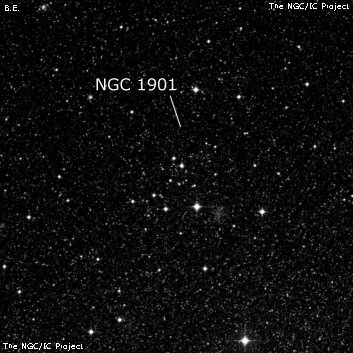
John Herschel discovered NGC 1901 = h2824 on 30 Dec 1836 and described "a star 7th mag. The most southern and largest of a large, brilliant but poor cluster which fills the field. Stars 8, 9 ... 12th mag." His position is close west of mag 7.6 HD 35230.
In "Some NGC objects in the Large Magellanic Cloud" (1964IrAJ....6..286L) Eric Lindsay comments, "Centered on CPD -68?347. A dozen fairly bright stars, of which CPD 68?347 is the brightest and most southern, scattered within 11' diameter. Could hardly be considered a cluster and resembles mroe nearly a field irregularity." The brighter field stars are not associated with the LMC. But "A stellar group in line of sight with the Large Magellanic Cloud." (1968AJ.....73..566S) concludes, "BV photometry of a stellar group first noticed by Bok in line of sight with the Large Magellanic Cloud indicates that the group is real. An H-R diagram shows an apparent main sequence with a turnoff near A0."
300/350mm - 14" (4/7/16 - Coonabarabran, 145x and 178x): very scattered cluster of stars in a 15' region. The central grouping, extending 7'x2.5', is the most compressed with ~15 stars (7 of these are fairly bright). Perhaps 40 stars total within 15', including 10 brighter stars. The brightest stars are mag 8.4 HD 35294 in the central group and mag 7.6 HD 35230 on the southwest end. This sparse Milky Way cluster (neither of the two brightest stars are members) is superimposed on the LMC. The LMC cluster S-L 359, just 1.3' WSW of the mag 8.4 star, was not seen.
Notes by Steve Gottlieb